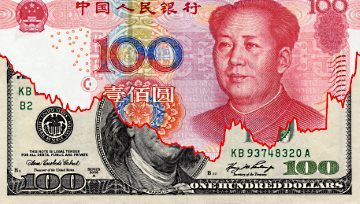Weekly DailyFX Economic Calendar
Trader Snapshot – Fundamental Themes to Keep Watch for Next Week:
- Growth Forecasts Via PMIs
- Central Bank Forward Guidance
- US-China Trade War Headlines from China – Trump-Xi Meeting
- US Commerce Department Ruling on Auto Tariffs
- China Financial Stability and Growth
- Brexit May-EU Negotiators Rhetoric
- Volatility Hitting New Lows
- Fading Global Sentiment (Consumers, Businesses, Governments, Investors)
Far More to Lose Should the US-China Relationship Falter Now
The clouds are undoubtedly clearing from the US-Chinese trade relationship – at least they are in the market’s perception of the situation. This past week, the headlines relating to the ongoing US-Chinese negotiations (in China) produced an unusual run of optimism among officials. Up until recently, the insight offered from US insiders would skew heavily towards the cynical – with very brief interludes of encouragement. It hasn’t been difficult to pick up on the Trump Administration’s aggressive negotiation position over the past months.
After a number of separate instances in the past where the Asian superpower has committed to open access to its markets and economy as well as comply with international laws – only to disregard their time frames and objectives later – it comes as little surprise that the hardline leaders of the US negotiation team are advising pushing China as far as possible.
In the meantime, China has attempted to keep pace with the direct tariffs without triggering a collapse into currency wars only to run out of tariffs to tax, all the while the planned slowdown in economic activity and transition away from excess debt has accelerated to the point of jeopardizing the soft landing the government and central bank have struggled to manufacture. Against these multi-fronted threats, the world’s second largest economy will eventually have to capitulate to some of its trade partners more aggressive demands. We may be near that turning point if these remarks are any indication.
This past week, Chinese media indicated that the United States was close to receiving everything it sought in the negotiations with the predictable disclaimer that the country would keep its ‘dignity’ in the discussions. President Trump remarked on negotiations during his border security speech, saying the talks were going well and he expected trade between the two countries to increase significantly going forward. As flippant as the President, negotiators and the media have been on this particular subject; perhaps the most reliably encouraging news was that the Chinese envoy would return to the US to continue talks this week and President’s Xi and Trump would meet soon after.
If this is the plan, then they are very likely to be in the final stages of settling on a deal. Looking at the recovery mounted by risk benchmarks like the S&P 500 and Dow over the past six weeks, it would seem that the markets are fairly confident that we should find a breakthrough. However, this anticipation sets the bar high for fostering investor enthusiasm.
As is often the case surrounding such significant fundamental themes, we are witnessing a certain degree of ‘buy the rumor’. That doesn’t mean that we have to book end the traditional saying with a ‘sell the news’ but the speculative leverage is likely already dampened and the absence of a resolution will almost certainly trigger a reversal – even if much of the buoyancy around the market wasn’t based on this particular theme itself. And, as I’ve suggested numerous times before, one of the greatest and underappreciated risks would be a reversal in the broader markets despite a resolution to the US-China trade wars. If resolving one of the greatest burdens to the global forecast can’t reinstall the decade-long bull trend, what can?
Potentially Trading One Trade War Battle for a Far More Significant One
The trade wars have unfolded on multiple fronts – and even began with a global opening salvo – yet much of the focus has concentrated on the particular escalations between the United States and China. That isn’t surprising given the two are the largest economies in the world with enormous control over capital currents around the world and reserves in what is traditionally considered the risk-free benchmarking for pricing of virtually every asset across the spectrum. There is still a scattershot metal (steel and aluminum) tariff that the United States has applied to a number of its trade counterparts, but this policy has been absorbed and the world has moved on. How well would we be able to adapt to the United States adopting a hefty import tax on foreign autos and auto parts?
The US Commerce Department began investigating the economic and national security implications of auto imports at the President’s request back in May. The report would be due as early as February 17th (Sunday). The willingness to pursue this avenue would likely be bolstered by a resolution between the US and China as it could be used as evidence that such efforts ‘pay off’. That said, the risks of global economic blowback from this type of engagement would be far more severe for the developed world markets. Among the largest exporters of autos destined for the United States are Japan and Eurozone members. These are not emerging market players who have fallen short on their promises to meet global trade arrangements. They are some of the key players on the free-market global stage.
While Japan has been more restrained on voicing its commitment to retaliate should the United States pursue onerous taxes against its country’s manufacturers, the EU has not been shy. When the threats have been circulated through the press by President Trump previously, the EU’s leaders and trade minister have taken the opportunity to clearly state their position: that they were ready with retaliation that would immediately reach the hundreds of billions of dollars.
If the US were so bold as to pursue this line, it would not find the half-hearted support from other trade partners as it turns the screws on the regularly backpedaling China. It would encourage the world to take a more unified stance against the world’s largest consumer with short-term, punitive retaliation and accelerating long-term efforts to diversify away from the US by more rapidly building bi-lateral accords. As that transition slowly takes hold, there would be a much higher probability that the slowdown in the global economy thus far would be tipped to full stall or even contraction.
Troubling Memories of the Extreme Volatility from Summer 2014
For those that have been in the FX for a while, there is likely some discomfort with the slide in activity levels that we have seen lately. You can measure activity in a number of ways, but the most popular is either through implied volatility or quantitative historical price measures like the popular ATR (Average True Range). Implied volatility in the equity market – most popularly quoted via the VIX volatility index – has only dropped back to levels that precede October’s explosion.
However, similar option’s-sourced measures for the currency market show some of the most liquid areas of the asset class have dropped back even further into complacency. The 50-day moving average on the CBOE’s Euro volatility index has dropped to its lowest levels since the holiday period between the end of 2017 and beginning of 2018. If it slides lower, it will return to conditions not seen since the fall of 2014. That is implied, or expected, levels of volatility. The realized measures are already plumbing such historical lows. One of the most basic measures of price-derived activity, the 20-day ATR (equivalent to one trading month) on the EURUSD has actually hit lows not experienced since September 2014.
For those not active during that period, it is worth some reflection. Trading through the summer of 2014 reflected an almost preternatural advance in capital markets with extraordinarily restricted counter-trend swings – not bad for buy-and-hold bulls. Yet, for the FX market, the quiet was reflected in extremely diminished interim swings, but there was little in the way of a prevailing trend owing to the utter lack of carry potential considering the world’s central banks were still sporting near-zero rates and, in many cases, unprecedented stimulus programs. Are we destined for a similar bout of dead market? We can’t argue with where current activity levels stand, but there is significant disparity in the fundamental backdrop back then and what we are experiencing now. For one, the quiet in 2014 was the culmination of multiple years of restraint.
What we find now is more of a relief following multiple spells of extreme volatility through 2018. Furthermore, the backdrop of quiet supported by extreme monetary policy charging an otherwise sanguine economic and financial backdrop is replaced with concern over the cost of the previously-thought panacea (stimulus) along with a host of possible triggers for fear (trade wars, economic cycle terminating, etc). Our environment in other words is at constant risk of igniting the complacency that currently prevails. However, just because the fuel is there doesn’t mean it has to ignite.
--- Written by John Kicklighter, Chief Currency Strategist.
To contact John, email him at john.kicklighter@ig.com
Follow John on Twitter @Johnkicklighter.





